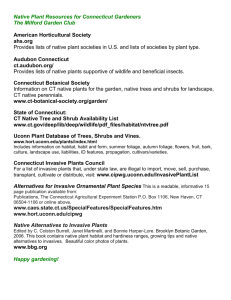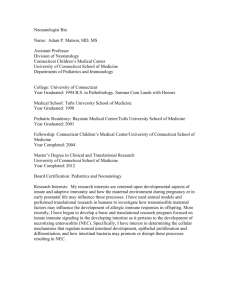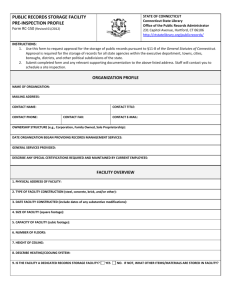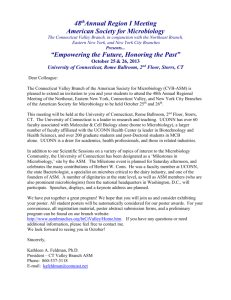Vision for University of Connecticut Tech. Park
advertisement
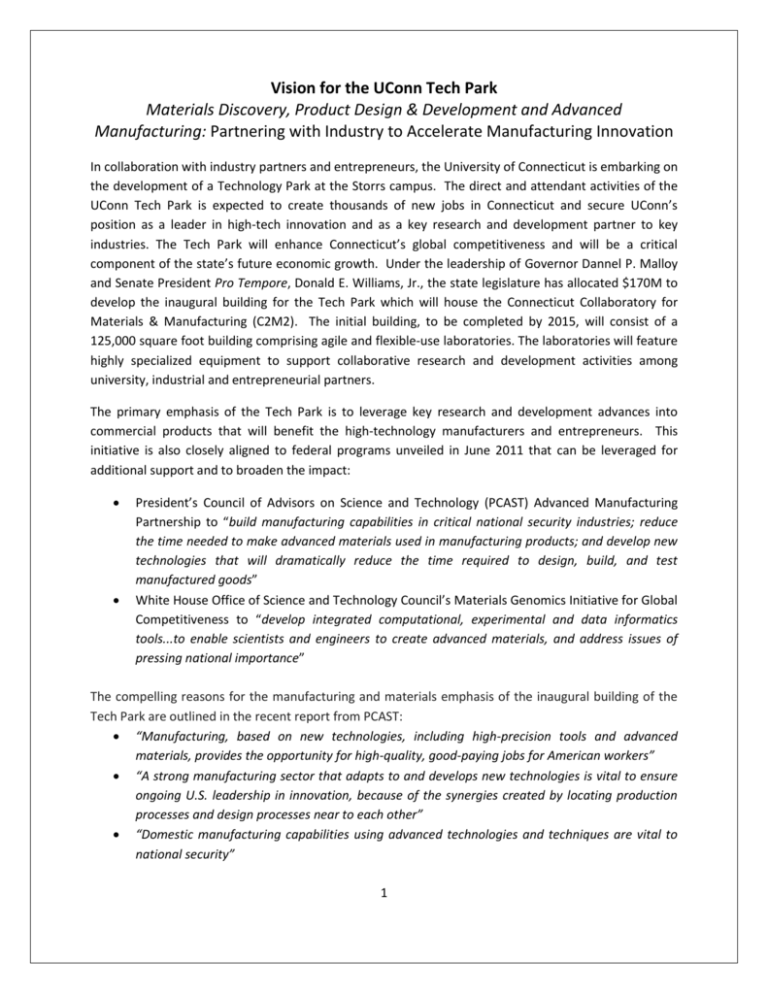
Vision for the UConn Tech Park Materials Discovery, Product Design & Development and Advanced Manufacturing: Partnering with Industry to Accelerate Manufacturing Innovation In collaboration with industry partners and entrepreneurs, the University of Connecticut is embarking on the development of a Technology Park at the Storrs campus. The direct and attendant activities of the UConn Tech Park is expected to create thousands of new jobs in Connecticut and secure UConn’s position as a leader in high-tech innovation and as a key research and development partner to key industries. The Tech Park will enhance Connecticut’s global competitiveness and will be a critical component of the state’s future economic growth. Under the leadership of Governor Dannel P. Malloy and Senate President Pro Tempore, Donald E. Williams, Jr., the state legislature has allocated $170M to develop the inaugural building for the Tech Park which will house the Connecticut Collaboratory for Materials & Manufacturing (C2M2). The initial building, to be completed by 2015, will consist of a 125,000 square foot building comprising agile and flexible-use laboratories. The laboratories will feature highly specialized equipment to support collaborative research and development activities among university, industrial and entrepreneurial partners. The primary emphasis of the Tech Park is to leverage key research and development advances into commercial products that will benefit the high-technology manufacturers and entrepreneurs. This initiative is also closely aligned to federal programs unveiled in June 2011 that can be leveraged for additional support and to broaden the impact: President’s Council of Advisors on Science and Technology (PCAST) Advanced Manufacturing Partnership to “build manufacturing capabilities in critical national security industries; reduce the time needed to make advanced materials used in manufacturing products; and develop new technologies that will dramatically reduce the time required to design, build, and test manufactured goods” White House Office of Science and Technology Council’s Materials Genomics Initiative for Global Competitiveness to “develop integrated computational, experimental and data informatics tools...to enable scientists and engineers to create advanced materials, and address issues of pressing national importance” The compelling reasons for the manufacturing and materials emphasis of the inaugural building of the Tech Park are outlined in the recent report from PCAST: “Manufacturing, based on new technologies, including high-precision tools and advanced materials, provides the opportunity for high-quality, good-paying jobs for American workers” “A strong manufacturing sector that adapts to and develops new technologies is vital to ensure ongoing U.S. leadership in innovation, because of the synergies created by locating production processes and design processes near to each other” “Domestic manufacturing capabilities using advanced technologies and techniques are vital to national security” 1 Leveraging & Expanding Core Competencies Connecticut has a rich heritage as well as a wellspring of innovation and a nucleus for precision manufacturing. To sustain this tradition of excellence and to promote economic development, industries from all sectors will need to implement continuous improvement, innovations and cost and resource reductions to compete in the global economy. In 2005, the Battelle Memorial Institute Core Competency report identified the following core competencies for Connecticut: 1. Advanced Product Development Advanced Materials for Precision Manufacturing Additive Manufacturing and Nanoscale Processing Fuel Cells, Sustainable Energy & Energy Management Systems Optoelectronic Systems & Devices 2. Biomedical Engineering Bioimaging & Sensors Biomaterials & Tissue Engineering Biomedical Devices 3. Advanced Information Systems Modeling & Predictive Analysis Cyber-Physical Systems & Sensor Networks Information Security 4. Translational Medicine Personalized Medicine Stem Cell Applications Targeted Drug Development Clinical Research Consortium In appreciation of the key role that translational medicine will play in the Bioscience Connecticut initiative (with $864M in support from state and the private sector), this core competency will be an area of focus at the Farmington campus. According to the 2008 GHG Tech Park Feasibility Study, the “[UConn] research park should be broad enough to allow for market support, the marketing should focus on those technology sectors with the highest potential for relocation and collaboration with the University and technology companies in the area”. The emphasis of the first Tech Park building at UConn will be to broadly serve the 8,000 companies (located within a 120-mile radius of Storrs, CT) that are closely aligned with the three core competencies of advanced product development, biomedical engineering, and advanced information systems. While their sizes, markets and technologies vary widely, there is a unifying theme of the central role that advanced materials and manufacturing will play in their future viability and growth. To effectively compete, manufacturing companies must focus more intensely on their core competencies while adapting new developments from diverse fields to improve their competitive advantage. In this new environment of rapidly expanding portfolio of available technologies, the principal objectives of the Connecticut Collaboratory for Materials & Manufacturing (C2M2) are to provide Connecticut companies with access to discovery, product development and design, and manufacturing. 2 Key Processes Discovery Product Development Product Design Manufacturing Key Applications Advanced computational and experimental techniques for analyzing advanced materials and processes to obtain breakthrough properties Characterization, testing and property optimization of products and processes using computational and experimental methods Selection of advanced materials and processes for desired properties, performance, systems integration and certification Development of agile, sustainable and efficient manufacturing techniques to implement new materials and processes into advanced components, devices and information systems for the needs of the marketplace This foundational approach (of emphasizing advanced product development, biomedical engineering, and advanced information systems) will benefit the key growth clusters that were recommended in the “Partnership for Growth II, which combines the knowledge and insights of the members of the Governor’s Council on Economic Competitiveness and Technology with those of thousands of community, civic and business leaders from across Connecticut.” Aerospace & Defense Advanced Product Development Biomedical Engineering Advanced Info Systems Metals Plastics Manufacturing Manufacturing Sustainable Energy Bioscience Maritime A 2009 NIST Client Impact Survey of over 9,000 national manufacturing firms identified the strategic challenges of continuous improvement, growth, product innovation and sustainability: Strategic Challenge % of Clients Reporting Identified Strategic Challenge as Being Important Ongoing Continuous Improvement 70% Identifying Growth Opportunities 58% Product Innovation/Development 47% Sustainability in Products and Processes 24% The success of the Tech Park will be measured by our ability to meet these universal needs of industry partners. 3 Collaboratory Resources – it is envisioned that the Tech Park will meet the comprehensive needs of industry, university and entrepreneurs through: Intellectual Assets o 20 to 25 new faculty members will be recruited in the areas of advanced manufacturing and materials as part of the Eminent Faculty Program and other strategic hiring efforts that are aligned to the university academic plan o Innovative industry-sponsored projects that involve undergraduate and graduate students from a variety of disciplines at UConn o Industry researchers in residence to lead collaborative projects with faculty and students o Visiting scholars from U.S. and international academic institutions to strengthen the research activities of C2M2 o Entrepreneurs to advise industry partners, faculty and students in leveraging C2M2 innovations and identifying market needs that will drive the discovery-to-market process. Physical Assets o Manufacturing and processing equipment (The list below is for informational purposes only. The final list of equipment will be identified through regional analysis of capabilities and with input from industry and university experts. Unique capabilities will be sought that will avoid duplications with other centers in the region.) o Additive manufacturing for electron beam melting for high-temperature alloys; selective laser melting of ceramics/metals; laser sintering of high performance polymers; aerosol jet technology equipment for printed electronics o Class 1000/100 clean rooms and bio-nanofabrication facility o Lithography, including direct beam write (mask-less) and nano-imprint systems o Thin-film deposition, including plasma enhanced chemical vapor deposition, thin film deposition and oxidation tubes, e-beam/thermal evaporator and an RF sputter systems o Characterization equipment (The list below is for informational purposes only. The final list of equipment will be identified through regional analysis of capabilities and with input from industry and university experts. Unique capabilities will be sought that will avoid duplications with other centers in the region.) o High-throughput combinatorial processors for material screening for mechanical and wear properties, structural, electrical, magnetic, thermal, acoustic, optical, chemical and biological properties o Transmission Electron Microscopes (TEMs) and Scanning Electron Microscopes (SEMs) for high resolution visualization of nano-characteristics of both structural and biological systems o Surface analysis tools, including Auger and X-ray Photoelectron Spectroscopy (XPS) to develop medical devices and advanced composite materials for manufacturing sectors o Scanning Tunneling Microscopes (STMs) and Atomic Force Microscopes (AFMs) for imaging, measuring, and manipulating matter at nanoscale o Chemical analysis equipment, including atomic absorption spectrometer, inductively coupled plasma mass spectrometer, etc. Cyber Assets o High-performance computing clusters for multi-scale modeling and simulation of material dimensions, from the nanoscales of crystal structures to the mesoscales of components, and 4 o time resolutions, from the picoseconds of molecular interactions to the years required to assess durability and wear Advanced informatics, data visualization, cyber-physical infrastructure (sensor networks, analytics and robotics systems) and virtual reality modeling for robust product design and development of new materials, devices, processes and information systems In addition, the Tech Park will provide much-needed incubation space for technology entrepreneurs and partnering companies, with business support, mentoring and planning resources; library access including electronic collections; and faculty expertise, specialized instrumentation and other core facilities campus wide. Partnering for Innovation, Competitiveness and Job Creation The ambitious new Tech Park at the University of Connecticut in Storrs will provide industrial partners with unprecedented opportunities to contribute toward a new model of private-public collaboration. With 300 acres, master-planned for 1.2 million square feet of building space, the Tech Park will attract and support innovative technology firms. The inaugural building which will house the Connecticut Collaboratory for Materials & Manufacturing which will: Create jobs, new business startups and economic development; Accelerate innovation in industry, from startups to mid-size and large corporations; Provide an interface linking basic research and industrial applications; Serve as the key technology development partner for funding recipients from Connecticut Innovations; Connecticut Energy, Finance & Investment Authority; Connecticut Development Authority, CONNSTEP, SBIR, etc.; Serve as a modern platform and showcase for breakthroughs in energy efficiency, cyber-physical systems, advanced building control and security; Enable the State of Connecticut and its many agencies to serve as a test-bed of innovative technologies. The Tech Park Vision document was developed with input from key industry partners, entrepreneurs and state officials. The emphasis of the Tech Park will continue to improve through technological developments and evolve to meet the economic development needs of the State of Connecticut. References Battelle Memorial Institute. 2005. Building upon Connecticut Core Competencies in the Knowledge Economy: A Case Statement for Meeting Challenges of the 21st Century Knowledge Economy. George Henry George Partners. 2008. Feasibility Study for a Research and Technology Park at the University of Connecticut. National Science and Technology Council. 2011. Materials Genome Initiative for Global Competitiveness. Executive Office of the President, Washington, D.C. President’s Council of Advisors on Science and Technology. 2011. Report to the President on Ensuring American Leadership in Advanced Manufacturing. Executive Office of the President, Washington, D.C. 5




